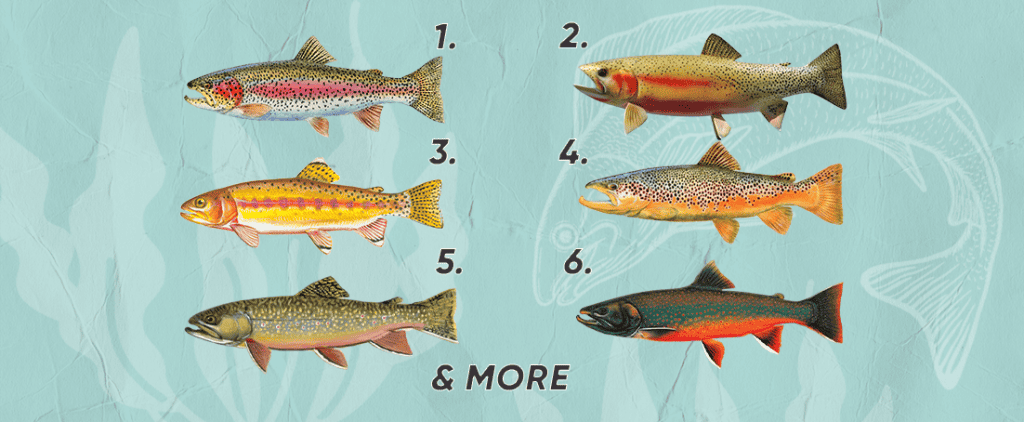
Trout species are popular game fishes belonging to the Salmonidae family. They are the most sought-after freshwater species as they are delicious and sporty to catch. As a beginner, distinguishing all types of trout can be quite confusing as they have almost similar features. There are over 15 species of trout, and most of them prefer living in cool, clear lakes and streams.
This guide will explain everything you need to know about trout species. We will also discuss how many types of trout there are and their distinguishing features.

I love to test new fishing gadgets and share my opinion.
Table of Contents
Trout Varieties to Add to Your Bucket List: What does a trout look like?
Rainbow Trout (Oncorhynchus mykiss)

These species are among the most sought trout species in America. You can identify them by the pink stripe found along their sides. You can also recognize them by their square tail and black spots in their dorsal fin.
Rainbow trout can grow up to 30 inches and weigh up to 8 pounds. However, the size and weight vary depending on the location and subspecies. The most popular subspecies of rainbow trout include the golden rainbow trout and the redband trout.
Rainbow trout are commonly found along the Pacific coast, from Alaska to Mexico. They are also found in Great Lakes, Canada, Alabama, and Georgia.
Nowadays, anglers across the region are stocking rainbow fish because they are perfect for sport fishing. Remember, you can find rainbow trout on all continents except in Antarctica.
Cutthroat Trout (Oncorhynchus clarkii)
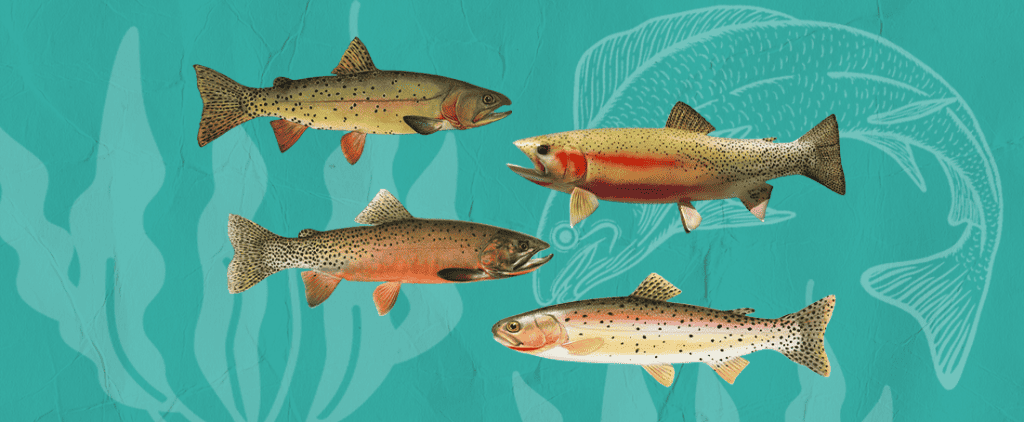
Cutthroat trout have orange or red coloring along the throat and lower jaw and black dots on their back.
A mature cutthroat trout can grow up to 40 inches long, although you can find some as small as six inches. Additionally, cutthroat trout can weigh from as low as 0.4 ounces up to 41 lbs.
Cutthroat trout species are commonly found on the western side of the US along the Pacific coast. Other areas you can find them include southwestern Canada, Alaska, Quebec, and the northeastern side of the US.
There are 11 other subspecies of the cutthroat trout, each with a unique appearance. The widespread cutthroat trout subspecies include the Bonneville, Yellowstone, Colorado River, Lahontan, and Snake River.
Golden Trout ( Oncorhynchus aguabonita)
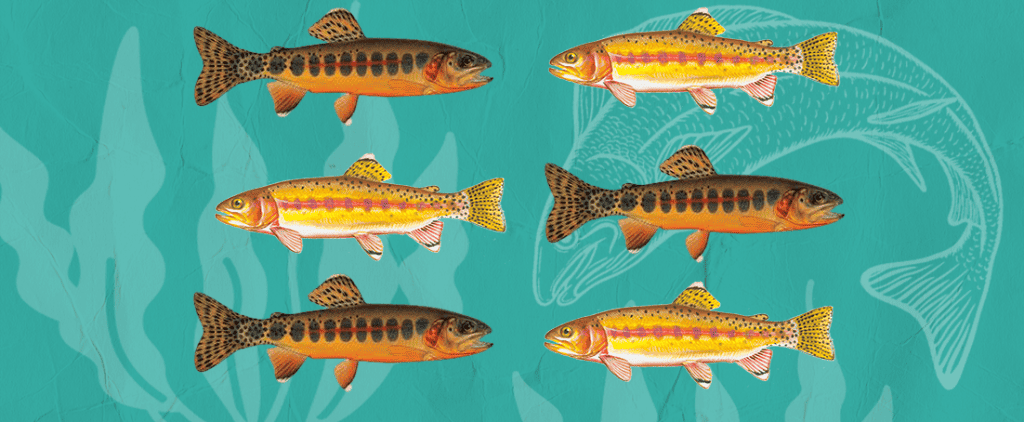
Golden trout are popular sportfish in Notrh America. As their name suggests, golden trout have golden sides and a bright red horizontal line along the lateral line. Also, you can identify them by their spotted darker tails.
Golden trout are common in freshwater rivers and lakes in highland regions. They are popular in the western united states, especially in Washington, Wyoming, California, and Idaho.
A mature golden trout can grow up to 12 inches in length and weigh up to 11 pounds. Remember, the weight depends on the habitat, as some golden trout are as small as 6 inches.
The fishing season for golden trout starts in May when the weather is warmer and ends in September. During this season, carry the right spinning rods designed for golden trout fishing.
Brown Trout (Salmo trutta)
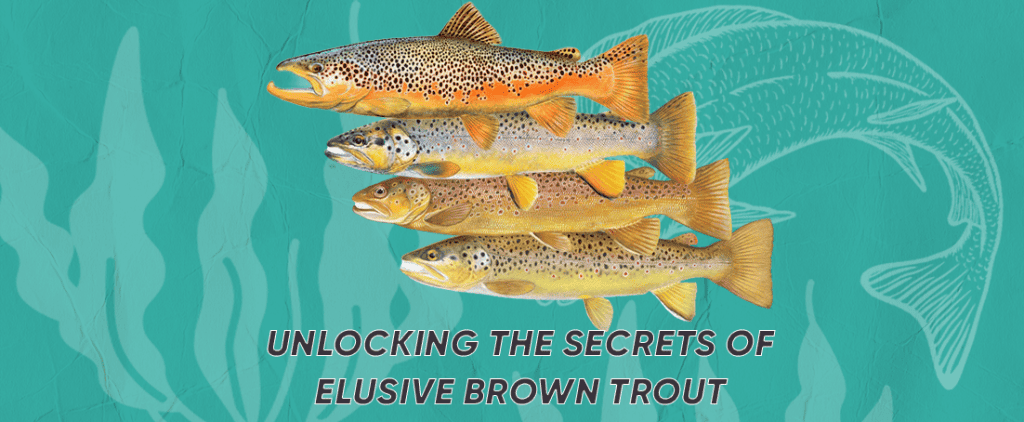
Not all brown trout have a brown color. Some trout species have reddish-brown bodies, while others have silver and golden appearances. Their appearance varies depending on their habitat.
You can identify brown trout by their orange-red spots surrounded by a silver ring. Since brown trout are related to Atlantic Salmon, you will notice they have a salmon look at a glance.
Brown trout can weigh up to 44 lbs. and grow as long as 39 inches. These species are natively found in most European water bodies. They are also found in Russia, Norway, Pakistan, and Iceland.
Since brown trout is a popular sportfish caught with various trout lures, they have been introduced in other continents, including America, Asia, Australia, and America. Remember, brown trout are subdivided into several subspecies, such as sea and lake trout.
Lake Trout (Salvelinus namaycush)
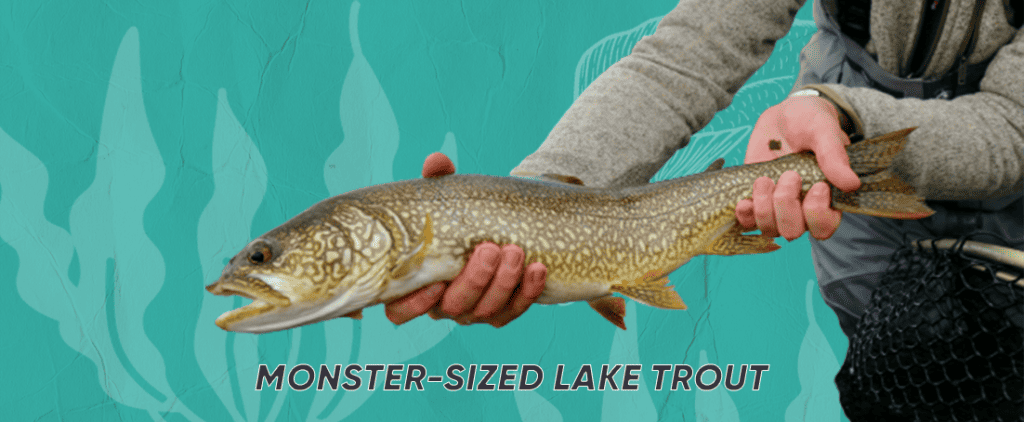
Lake trout are among the largest trout species. Although you can identify them by their size, there are other distinguishing factors you should be aware of. Lake trout’s body has creamy spots, and its tail is deeply forked compared to other trout species.
On average, a lake trout can grow between 24-36 inches in length and weigh between 15 to 40 pounds. However, some lake trout can grow more than the average weight, as some can weigh up to 100 pounds.
Lake trout are natively found in Canada, the Northeastern US, and Alaska. Since they are popular for sportfishing, they have been introduced in other regions, including South America and Europe.
You can catch trophy lake trout through the trolling fishing method, especially if you use the recommended trout trolling lures and baits.
Brook Trout (Salvelinus fontinalis)

Brook trout are popular game fish in North America. You can easily identify them by their distinctive dark spots and some unique red spots rounded with blue halos along the sides.
You can also identify them with margins at the edges of their ventral fins. Their mouth is also significant, extending back past their eyes.
Brook trout can grow up to 25.6 inches in length and weigh up to 6.61 lbs. They also like living in cold regions and are common in North America.
You can find them in the Great Lakes, except in Lake Erie. Other places you can find brook trout include Europe, New Zealand, Argentina, and Australia.
Dolly Varden Trout (Salvelinus malma)

Dolly varden trout are common in most lakes in North America. These species usually have a greenish body covered with many small spots. They also have a relatively thick constriction at the base of the tail fin. Their tail is also slightly forked, not as deep as lake trout.
Unlike other trout species, dolly varden trout don’t grow as big as they can only weigh up to 10 pounds. Remember, freshwater dolly varden trout can grow up to six inches long.
These species are common in the Arctic, especially in Alaska and northern Washington. Nowadays, you can find Dolly Varden in most rivers in Siberia and Japan.
Bull Trout (Salvelinus confluentus)
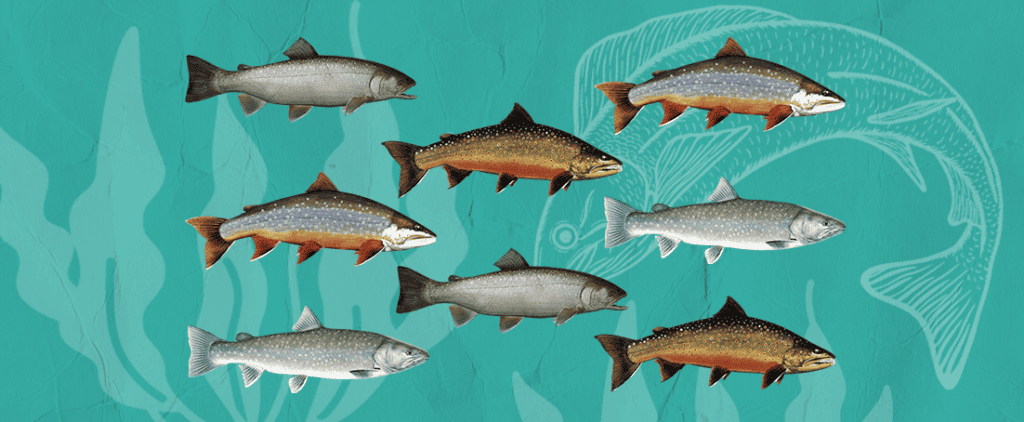
Bull trout are native trout species in British Columbia. They derive their name from their large heads and mouths and are among the rarest trout species. Unlike lake trout, bull trout has a flatter tail end and lacks markings on the dorsal fin.
Bull trout have uniform round spots on their back and like living in cold waters. The most common places you can find them include British Columbia, Alberta, Oregon, and Washington.
Bull trout are either migratory or non-migratory. They tend to grow larger as they can reach up to 41 inches in length and weigh up to 32 lbs.
Splake Trout (Salvelinus namaycush)

Unlike most trout species, splake trout is a crossbreed of female lake trout and male brook trout. Splake trout can weigh up to 20 pounds and grow up to 18 inches in length. Splake trout is liked for sportfishing as it grows faster than its parental species.
Since splake is a hybrid trout, it’s hard to distinguish it from brook trout as their coloration pattern is almost similar. However, looking closely, you will notice that splake has a slightly forked tail while brook trout has a square tail.
Splake trout have been effectively reproduced since the 1870s. These trout species have no native origin, but the largest breeding program is located in Ontario and then stocked in Georgian Bay and other smaller lakes.
Palomino Trout (Oncorhynchus mykiss aguabonita)

You can identify these species by their red horizontal markings along the lateral lines. Their bright appearance makes them the prized catch for sports anglers.
On average, Palomino trout grows between 15 to 19 inches in length and can weigh between two to four pounds. However, they can grow over 10 pounds as the largest Palomino trout to be caught weighed more than 13 pounds.
Also known as rainbow trout, these species are natively found on Pacific Coast. Due to conservation efforts, you can now find them in the Great Lakes, West Virginia, and Northwest Pacific.
Gila Trout (Oncorhynchus gilae)

Gila trout are rare to find and are named after the area they are natively found, the Gila River in New Mexico. Due to human destruction, the Gila population has declined.
The US Fish and Wildlife Service has put up a hatchery that stocks Gila trout and distributes them in lakes and rivers in the US. You can easily identify them by their yellowish-brown body covered with brown spots. Gila trout can grow up to 18 inches and weigh one lb.
Gila trout have golden yellow bodies and more significant dark spots on their adipose fin. They also have small dark spots above their lateral line, and the tips of their pelvic, dorsal, and anal fins have white or yellow tips.
Apache Trout (Oncorhynchus apache)
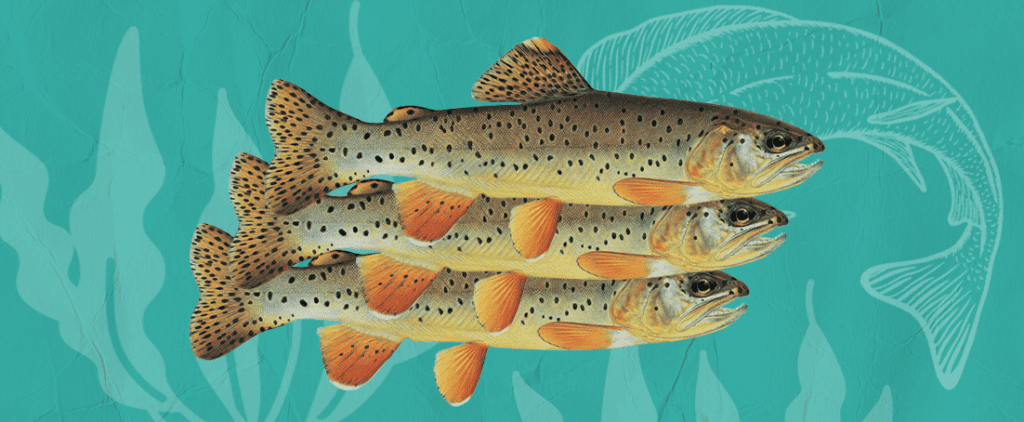
You can easily identify Apache trout by their dark head and olive-yellow body with a golden bellies. At a glance, they look like they are wearing masks over their eyes. They are native species in Arizona.
Apache trout can breed with rainbow and cutthroat trout. On average, apache can grow up to 32 inches in length and weigh up to 6 pounds. However, the largest Apache trout caught in Hurricane Lake weighed five pounds.
You can find them at White Mountain lakes and the streams of Apache Reservation land in Arizona. Due to conservation efforts, you can find these species in other areas, such as the Colorado River and near Lee Valley and Green Lake.
Marble Trout (Salmo marmoratus)
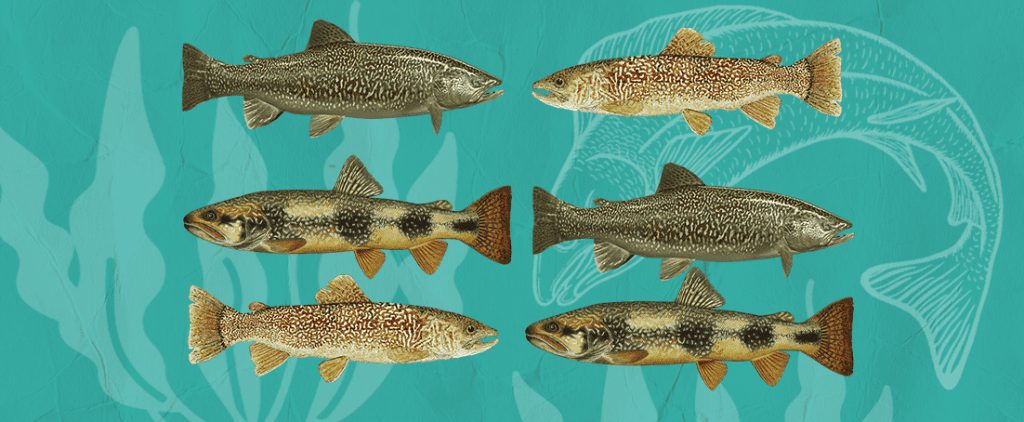
Marble trout belongs to the Salmonidae family. They can be identified by their distinctive marble-patterned spots and massive heads.
Marble trout have high growth capacity and can reach a length of up to 27 inches, and weigh up to 9 lbs. Although rare, some marble trout can weigh up to 14 lbs.
They are native species inhabiting streams and rivers flowing into the Adriatic Sea. They are common in Italy rivers such as River Brenta, River Adige, River Piave, and Natisone.
Marble trout habitat extends to other parts like Croatia, Slovenia, Montenegro, and Bosnia and Herzegovina.
Adriatic Trout (Salmo obtusirostris)

Adriatic trout belongs to the Salmonid family. You can identify them by their elongated snout and small, fleshy mouth.
Although the color varies between species, Adriatic trout have a greenish appearance with black and red dots. Adriatic trout can grow to a length of up to 30 inches and weigh up to 13 lbs.
Adriatic trout prefer living in rivers with a wide riverbed and more water. They are naturally found in the Adriatic Sea, Bosnia, Croatia, the Neretva Vrljika system, and the Krka River drainage. They have also been introduced in the Jadro River.
Ohrid Trout (Salmo letnica)
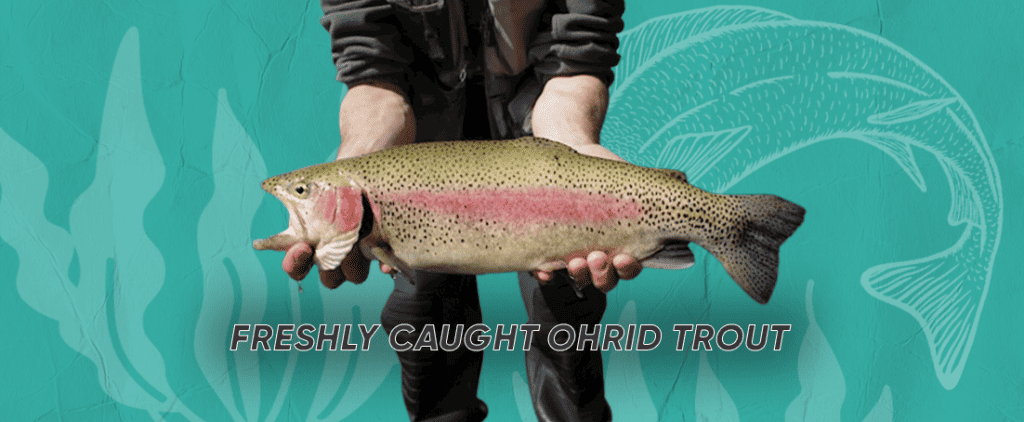
Ohrid trout is an endemic species of trout. These trout species are named after Lake Ohrid, as this lake is their native habitat. Other places you can find them include the Black Drim River found in North Macedonia.
Ohrid trout can grow to a maximum length of 31 inches and weigh up to 7 pounds. The size you catch depends on age; some can live for 7 years.
You can easily identify these beauties by their color. They don’t have a definite color, which changes depending on the age and environment.
Some Ohrid trout are black with red and blue spots, while others are adorned with sea-green spots. Most people like eating pink-colored Ohrid as they mainly feed on crustaceans and fish.
What Is A Trout?
Trout are freshwater fish species belonging to the Salmonidae family. They are closely related to salmon and char species as they belong to the same genera.
There are over 15 species of trout, and most of them prefer living in cool, clear lakes and streams. Most trout species are naturally distributed in northern parts of Asia, North America, and Europe.
Some trout species, like golden rainbow trout and brown trout, have now been introduced in New Zealand and Australia for sportfishing.
Trout feed on other fish and small invertebrates like caddisflies, mayflies, mollusks, stoneflies, and dragonflies. Those residing in lakes may feed on zooplankton, shrimp, and mealworms.
If you want to go trout fishing, you need to carry the right trout baits like brown lures designed for trout fishing, for example minnows and nightcrawlers.
Sportfishing & Trout - Inseparable Things
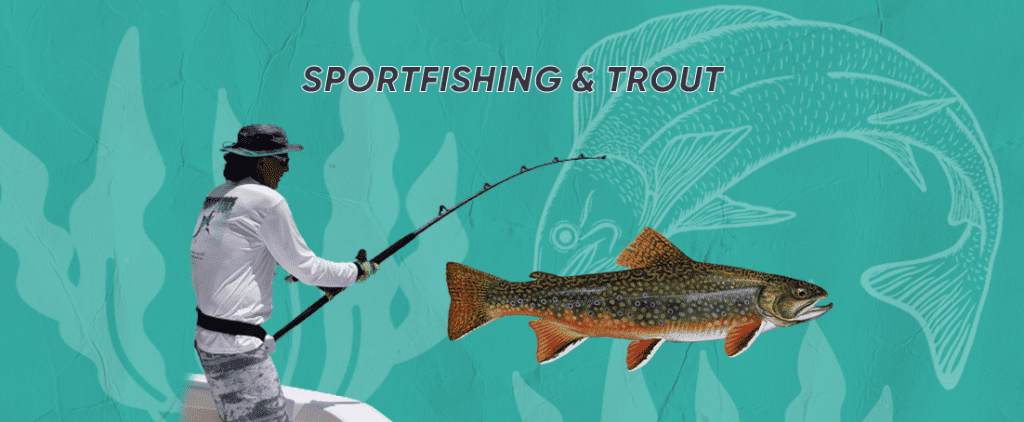
Trout are famous for sportfishing because catching them gives anglers a thrilling experience and satisfaction. For many anglers, it’s not about the catch but choosing the right trout fishing rod, baits or trout fishing reel and lures and this can be quite enjoyable.
Most trout varieties are ideal for sportfishing. However, the most sought-after trout species include bull trout, rainbow trout, brook trout, brown trout, tiger trout, lake trout, and steelhead trout.
For years, trout fishing has created cultural and historical significance. They have been used as a food source to create income, raise money, and offer population control to other species.
The money raised through sportfishing is used by wildlife management to conserve the environment and mitigate the negative impact of humans on the environment.
The conservation unit has put measures in place to ensure trout species are managed to stabilize the whole ecosystem. For example, trout were introduced to the Great Lakes to control the population of smaller invasive species.
The wildlife management units also introduced programs that seek to introduce new trout species in other regions while still calculating the possible damage it would cause to other species.
Stocked (Hatchery) Vs Wild Trout: What's the Differences?
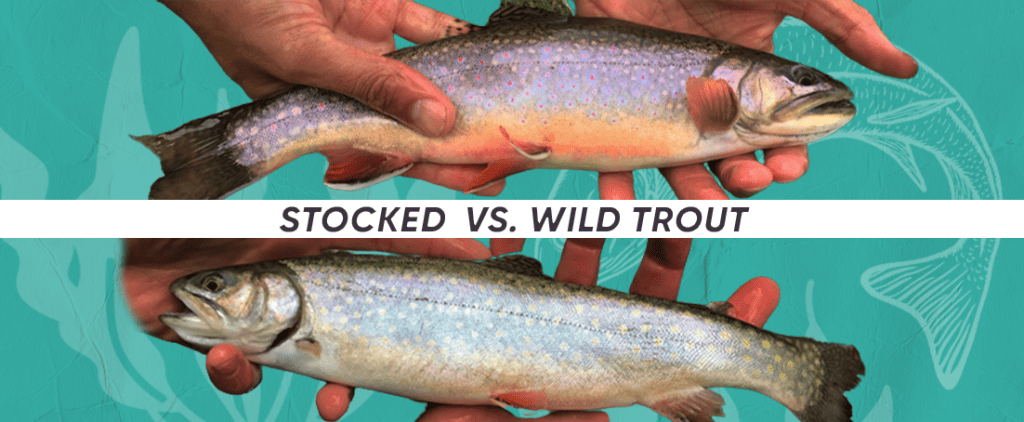
So, how many types of trout are there? How do you know whether they are wild or stocked? Here you will learn the difference between stocked and wild trout.
The Coloring
The color of stocked fish varies from that of wild trout, probably because of their diet. Wild trout feed on insects and other diverse insects, while stocked fish feed on pellets.
The lack of essential minerals and proteins affects the coloring of stocked trout. For example, a wild brook trout have bright orange and green colors, while the stocked one has basic green color and small yellow spots.
Additionally, stocked fish are grown in protected areas, so they don’t have to develop specific colors for survival. This is not the case in wild trout, as natural selection is a determining factor that makes them develop specific colors.
Damaged Skin or Fins
You can also distinguish wild trout from farmed ones by their appearance. Stocked trout are raised in hatcheries. Their body and fins are scraped and shredded because other species probably nipped them or the hard cement wall scrapped them.
When you catch a stocked trout, you will notice some scars in its dorsal or adipose fin derived from marking.
Fat Content on the Fish
Since both wild and stocked trout are reared in a different environments, they have different fat content. For example, stocked fish are reared in ponds where they feed on processed pellets. Due to a lack of enough exercise, they have an uneven distribution of fats.
They also feed on high-fat food that is not balanced, thus making them grow into large sizes. You know you’ve caught a stocked trout if it has more fat around its stomach.
On the other hand, wild trout spend most of their time swimming and looking for food. This makes them to have evenly distributed fat content. They also feed on smaller fish and other flies and don’t grow into larger sizes.
Eating Habits
The feeding habit of wild trout is entirely different from that of a stocked fish. Wild fish has spent their years looking for organic food and flies, while a stocked fish depends on being fed.
When released in the lake, it will take time before they adapt to their feeding habits. Some stocked fish don’t eat flies and will only eat eggs and corn.
Since they have spent their entire life in captivity, some species, like stocked speckled trout, are easy to catch, primarily if you use the recommended trout lures like speckled lure.
Local Regulations and Location
Most states indicate whether the river or lake you’re fishing is stocked with trout. You will find markings and signs in the lake or river you’re fishing at indicating the presence of stocked fish.
However, the presence of such markings doesn’t mean you can’t find wild trout there. If the waters are clear enough to hold trout, you may catch a wild trout. Be sure to use the above distinguishing features if the lake or river you’re fishing at hosts both wild and stocked trout.
